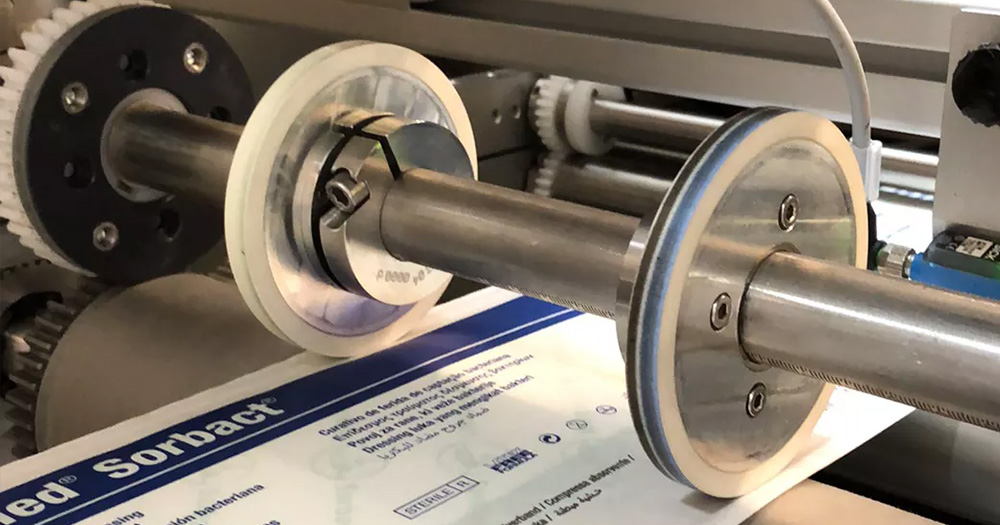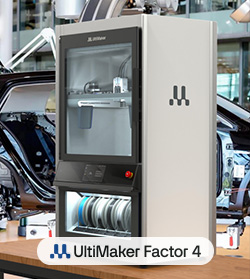ABIGO Medical and INTAMSYS - Reverse Engineering and 3D Printing

By printing some pulley wheels from a packaging line with the INTAMSYS FUNMAT HT printer, the maintenance department of ABIGO Medical AB was able to keep the packaging line running when the delivery time of the spare parts turned out to be eight weeks.
“The 3D printed parts stayed for nine weeks in the line and proved to be ten times cheaper than the original parts” - Linus Göhle, production technician
As a pharmaceutical company, Swedish ABIGO Medical AB is mainly involved in the development, production, and distribution of wound care products. These include some unique, patented products developed in-house, with which ABIGO is internationally active.
Production takes place in the company’s own factory in Askersund, under strict regulations. The latter was a reason for Linus Göhle, as production technician responsible for the maintenance of the production lines, to look for a High Temperature 3D printer.
“Right from the start, I have been looking for a 3D printer with which you can print PEEK and ULTEM, because we’re in a strictly regulated business. For some things we really need approval for the materials we use.”
Bridging long delivery times
ABIGO Medical has invested in the FUNMAT HT printer from INTAMSYS, the entry level model of a line of High Temperature capable 3D printers from the Chinese manufacturer. Thanks to the heated build chamber (90℃), heated printbed (160℃) and the hardened nozzle (up to 450℃), this 3D printer is suitable for printing with high quality polymers such as PEEK and PEKK.
“Printing with PEEK is really not difficult. We printed the INTAMSYS PEEK filament with the standard settings in the slicer, without any warping and with good adhesion of the layers”, says Linus Göhle. One of the parts printed is a set of spare parts for one of the new production lines in the factory. The pully wheels that pull paper into the sealing unit of the packaging line were worn out; the rubber around them had become too hard, leading to malfunctions.
Linus Göhle: “It’s a fairly young packaging line for which we didn’t have any spare parts in stock yet. The delivery time for original spare parts turned out to be seven to eight weeks. Too long.”

Reverse engineering and 3D printing
That’s why Linus Göhle started to reverse engineer the wheels to print them on the INTAMSYS FUNMAT HT with PEEK. PEEK was chosen because the temperature in the packaging line can be up to 85~87℃. The wheel with a diameter of 92 mm is printed, after that he placed a rubber O-ring around it. With these 3D printed wheels, he wanted to bridge the 8 weeks till the delivery of the original parts. “We expected the printed wheels to last one or two weeks. Then we wanted to print a new set until the original replacement parts were delivered. In the end, the wheels remained in the machine for nine weeks.
Even then, they were still running smoothly. Meanwhile, the original parts had arrived, and the quality department wanted us to assemble them. But the PEEK printed wheel was still good,” says Linus Göhle.
3D printing 10 times cheaper
With this relatively simple solution, ABIGO Medical has solved the problem of slow delivery of spare parts, which might cause the line to shut down. To Göhle’s surprise, the printed parts proved to be about 10 times cheaper than the original replacement parts. However, the production technician notes that the life span of the original parts is longer. Meanwhile, Linus Göhle’s team 3D print more parts for replacement of worn out parts, including a bearing housing for a conveyor belt. The delivery time is not decisive here, it is just as short as printing yourself.
“The costs, however, are considerably lower. We printed the bearing housing for the conveyor belt in Polycarbonate for 100 €, while the original part, an aluminum part, costs 4,000 €”
The fit of the bearings in the housing is particularly good. “They fit like a glove.” 3D printing with Polycarbonate is just as easy on the INTAMSYS FUNMAT HT as with other materials. “I only had to tweak the default settings a little, not noticeable.”

Replacing aluminum parts
Polycarbonate is now the favorite filament of Linus Göhle and his colleagues at ABIGO Medical’s maintenance department. “Because the material has good mechanical properties, it prints easily and has a good price/print quality ratio.” Only if PEEK is really needed, they print with this material. For the maintenance team of the Swedish pharmaceutical company, the FFF printer from INTAMSYS is the right production tool to use reverse engineering to make spare parts if the delivery times are too long, the costs too high or when they see chances to improve parts by re-design.
Linus Göhle is already for quite some time following the developments in the 3D print industry. But a 3D metal printer to print aluminum parts is too expensive; the standard FFF printers for PLA do not offer enough possibilities because of the limited usability of this material.
The High Temperature capable INTAMSYS FUNMAT 3D printers show to be the right solution for the maintenance department, because now aluminum parts in a factory can be replaced by 3D printed parts, thanks to the usage of high performance polymers. “The reviews I have read about the INTAMSYS FUNMAT HT triggered my attention immediately,” says Göhle. The openness of the platform is an important criterion when choosing a 3D printer. “We work under strict rules. Sometimes customers demand that we only use materials that have been approved. For this, we must find suppliers who are open about the composition. That is why we choose an open platform.” As soon as he needs to print i.e. the punch from the sealing machine, PEEK will be the only material allowed to print this part for the packaging line for wound care products.

Instant good prints
What also surprised Linus Göhle is the quality that he was able to achieve directly with the standard settings for the INTAMSYS PEEK filament. “You read a lot about errors that can occur when 3D printing these kinds of high-performance filaments. I was surprised that we sliced the design, sent it to the INTAMSYS FUNMAT HT and a few hours later we had good parts to assemble in the packaging line.” The Polycarbonate filament used for printing comes from INTAMSYS. “We also tested cheaper filaments and for some materials we also have other suppliers. Sometimes we then must tweak a bit. With INTAMSYS filaments we do not have to.”
The High Temperature capable 3D printer now runs almost around the clock. “Not always for production parts, also for training and learning. Currently, three employees in the maintenance department can work with the INTAMSYS FUNMAT HT.” Linus Göhle does most of the drawing work himself.
“I notice that the printer is becoming more and more embedded in our workflow. We will use the printer more and more for maintenance work. The more we learn about the materials and the limitations, the more benefits we get from the printer.”
He is supported by Additiva AB, the Swedish partner of INTAMSYS. “During the installation, we received a one-day training. Now we can solve most of the issues over the phone, but there will be training in the future. This support is important, even though we already had experience with 3D printing.”
In Same Category
- Krones: Optimized 3D-printed parts & spares for customers anywhere
- La stampa 3D nel settore farmaceutico
- Tre Zeta Group - 3D printing for the footwear sector
- Angelini Pharma: from research to production of personalized drugs thanks to 3D printing
- Nissan implements 3D printed tools, jigs and devices in its assembly lines







Leave your comment